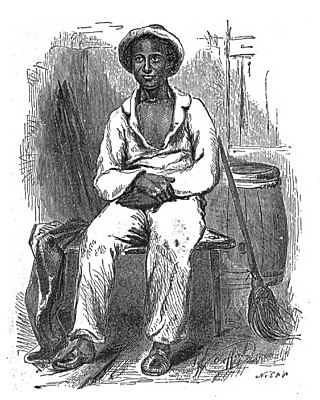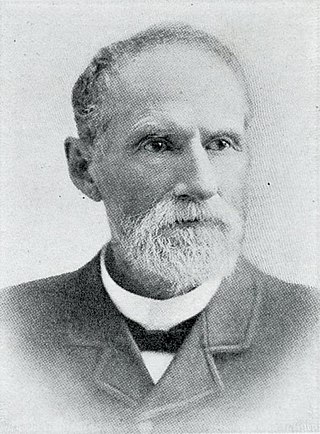Related Research Articles

Solomon Northup was an American abolitionist and the primary author of the memoir Twelve Years a Slave. A free-born African American from New York, he was the son of a freed slave and a free woman of color. A farmer and a professional violinist, Northup had been a landowner in Washington County, New York. In 1841, he was offered a traveling musician's job and went to Washington, D.C. ; there he was drugged, kidnapped, and sold as a slave. He was shipped to New Orleans, purchased by a planter, and held as a slave for 12 years in the Red River region of Louisiana, mostly in Avoyelles Parish. He remained a slave until he met Samuel Bass, a Canadian working on his plantation who helped get word to New York, where state law provided aid to free New York citizens who had been kidnapped and sold into slavery. His family and friends enlisted the aid of the Governor of New York, Washington Hunt, and Northup regained his freedom on January 3, 1853.

Dred Scott was an enslaved African American man who, along with his wife, Harriet, unsuccessfully sued for freedom for themselves and their two daughters in the Dred Scott v. Sandford case of 1857, popularly known as the "Dred Scott decision". The case centered on Dred and Harriet Scott and their children, Eliza and Lizzie. The Scotts claimed that they should be granted their freedom because Dred had lived in Illinois and the Wisconsin Territory for four years, where slavery was illegal, and laws in those jurisdictions said that slaveholders gave up their rights to slaves if they stayed for an extended period.
Rachel v. Walker (1834) was a "freedom suit" filed in the St. Louis Circuit Court by an African-American woman named Rachel who had been enslaved. She petitioned for her freedom and that of her son James (John) Henry from William Walker, based on having been held illegally as a slave in the free territory of Michigan by a previous master, an Army officer. Her case was appealed to the Supreme Court of Missouri, where she won in 1836. The court ruled that an Army officer forfeited his slave if he took the person to territory where slavery is prohibited. This ruling was cited as precedent in 1856 in the famous Dred Scott v. Sandford case before the Supreme Court of the United States.

Polly Berry was an African American woman notable for winning two freedom suits in St. Louis, one for herself, which she won in 1843, and one for her daughter Lucy, which she won in 1844. Having acquired the surnames of her slaveholders, she was also known as Polly Crockett and Polly Wash, the latter of which was the name used in her freedom suit.

Reuben Patrick Boise was an American attorney, judge and politician in the Oregon Territory and the early years of the state of Oregon. A native of Massachusetts, he immigrated to Oregon in 1850, where he would twice serve on the Oregon Supreme Court for a total of 16 years, with three stints as chief justice. Early in his legal career, he worked as a district attorney.
Nathaniel Ford was an American politician and Oregon pioneer during the time of the Oregon Territory. A native of Missouri, he worked as a sheriff in that state before moving to the Oregon Country where he was selected as judge in the Provisional Government of Oregon and served in the Oregon Territorial Legislature. Ford also lost a civil case that freed his slaves who he had brought across the Oregon Trail from Missouri.

Slavery in Indiana occurred between the time of French rule during the late seventeenth century and 1826, with a few traces of slavery afterward.

The Oregon Constitutional Convention in 1857 drafted the Oregon Constitution in preparation for the Oregon Territory to become a U.S. state. Held from mid-August through September, 60 men met in Salem, Oregon, and created the foundation for Oregon's law. The proposal passed with a vote of 35 for adoption to 10 against. Oregon then became the 33rd state of the Union on February 14, 1859.

The history of slavery in Missouri began in 1720, predating statehood, with the large-scale slavery in the region, when French merchant Philippe François Renault brought about 500 slaves of African descent from Saint-Domingue up the Mississippi River to work in lead mines in what is now southeastern Missouri and southern Illinois. These were the first enslaved Africans brought in masses to the middle Mississippi River Valley. Prior to Renault's enterprise, slavery in Missouri under French colonial rule had a much smaller scale compared to elsewhere in the French colonies.

George Mathews Jr., was a Judge of the Superior Courts of the Territory of Mississippi and the Territory of Orleans, and Presiding Judge of the Louisiana Supreme Court from 1813 until his death in 1836. His ruling in Marie Louise v. Marot was cited as precedent by dissenting U.S. Supreme Court Justice John McLean in the 1856 landmark Dred Scott v. Sandford case.

Marguerite Scypion, also known in court files as Marguerite, was an African-Natchez woman, born into slavery in St. Louis, then located in French Upper Louisiana. She was held first by Joseph Tayon and later by Jean Pierre Chouteau, one of the most powerful men in the city.

Freedom suits were lawsuits in the Thirteen Colonies and the United States filed by slaves against slaveholders to assert claims to freedom, often based on descent from a free maternal ancestor, or time held as a resident in a free state or territory.

Slavery in what became the U.S. state of Illinois existed for more than a century. Illinois did not become a state until 1818, but earlier regional systems of government had already established slavery. France introduced African slavery to the Illinois Country in the early eighteenth century. French and other inhabitants of Illinois continued the practice of owning slaves throughout the Illinois Country's period of British rule (1763-1783), as well as after its transfer to the new United States in 1783 as Illinois County, Virginia. The Northwest Ordinance (1787) banned slavery in Illinois and the rest of the Northwest Territory. Nonetheless, slavery remained a contentious issue, through the period when Illinois was part of the Indiana Territory and the Illinois Territory and some slaves remained in bondage after statehood until their gradual emancipation by the Illinois Supreme Court. Thus the history of slavery in Illinois covers several sometimes overlapping periods: French ; British ; Virginia ; United States Northwest Territory (1787-1800), Indiana Territory (1800-1809), Illinois Territory (1809-1818) and the State of Illinois.
History of slavery in Michigan includes the pro-slavery and anti-slavery efforts of the state's residents prior to the ratification of the Thirteenth Amendment to the United States Constitution in 1865.
The Oregon black exclusion laws were attempts to prevent black people from settling within the borders of the settlement and eventual U.S. state of Oregon. The first such law took effect in 1844, when the Provisional Government of Oregon voted to exclude black settlers from Oregon's borders. The law authorized a punishment for any black settler remaining in the territory to be whipped with "not less than twenty nor more than thirty-nine stripes" for every six months they remained. Additional laws aimed at African Americans entering Oregon were ratified in 1849 and 1857. The last of these laws was repealed in 1926. The laws, born of anti-slavery and anti-black beliefs, were often justified as a reaction to fears of black people instigating Native American uprisings.

Mary Jane Holmes Shipley Drake was an American slave involved in the Holmes v. Ford case, from which she gained her freedom in 1853.

Robert Wash served on the Supreme Court of Missouri from September 1825 to May 1837. During his term, the pro-slavery judge, who owned slaves himself, wrote the dissenting opinion on several important freedom suits, including Milly v. Smith, Julia v. McKinney and Marguerite v. Chouteau. However, he did join in the unanimous finding for the plaintiff in the landmark Rachel v. Walker case.
Robin Holmes was the plaintiff in an 1852 court case to free his enslaved children in the Oregon Territory.

Polly Strong was an enslaved woman in the Northwest Territory, in present-day Indiana. She was born after the Northwest Ordinance prohibited slavery. Slavery was prohibited by the Constitution of Indiana in 1816. Two years later, Strong's mother Jenny and attorney Moses Tabbs asked for a writ of habeas corpus for Polly and her brother James in 1818. Judge Thomas H. Blake produced indentures, Polly for 12 more years and James for four more years of servitude. The case was dismissed in 1819.
Mary Bateman Clark (1795–1840) was an American woman, born into slavery, who was taken to Indiana Territory. She was forced to become an indentured servant, even though the Northwest Ordinance prohibited slavery. She was sold in 1816, the same year that the Constitution of Indiana prohibited slavery and indentured servitude. In 1821, attorney Amory Kinney represented her as she fought for her freedom in the courts. After losing the case in the Circuit Court, she appealed to the Indiana Supreme Court in the case of Mary Clark v. G.W. Johnston. She won her freedom with the precedent-setting decision against indentured servitude in Indiana. The documentary, Mary Bateman Clark: A Woman of Colour and Courage, tells the story of her life and fight for freedom.
References
- 1 2 3 Bjornstad, Randi (16 February 2014). "Slavery in Oregon". projects.registerguard.com. Register-Guard. Retrieved 18 August 2017.
- 1 2 3 4 "Holmes v. Ford". oregonencyclopedia.org. Portland State University and Oregon Historical Society. Retrieved 18 August 2017.
- ↑ Lockley, Fred (1922). "The Case of Robin Holmes vs. Nathaniel Ford". The Quarterly of the Oregon Historical Society. 23 (2): 111–137. JSTOR 20610207.